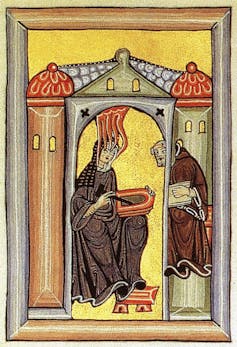ОÓÆÂÁųšÏēĘŋŠ―ąÖąēĨ the author: is Professor of Music and Associate Dean of Research for the Faculty of Arts and Social Sciences at ОÓÆÂÁųšÏēĘŋŠ―ąÖąēĨ.
Seventy-five years ago, in February 1945, during the Second World War, Allied forces bombed the magnificent baroque city of Dresden, Germany, and killing .
In central Dresden, however, a bank vault holding two precious medieval manuscripts survived the resulting inferno unscathed. The manuscripts were the works of the prolific 12th-century composer, writer and visionary, St. Hildegard of Bingen (1098-1179), who had .
Hildegard, whose writings documented her religious visions, and an , and who practised medicinal herbology, was venerated locally as a saint for centuries. The Catholic Church only recently recognized her as one, and also designated her a .
After the Dresden bombings, the Soviet Army seized and inspected the surviving vault. The first bank official to enter the vault afterwards found it pillaged, with only one manuscript remaining. The bank could never confirm if the vault was emptied in an official capacity or if it was plundered.
The missing manuscript has not been seen in the West since. The other made its way back to its original home of Wiesbaden, on the other side of Germany, through the extraordinary efforts of two women.
of how those women conspired to return the manuscript home.
The librarian
In 1942, Gustav Struck, the director of the state library in Wiesbaden, became worried about local air raids. Following many European institutions, he decided that his libraryâs manuscripts needed to be sent elsewhere for safe keeping.

Two of the libraryâs most valuable possessions were manuscripts of Hildegardâs works. One was a beautifully , a collection of 26 religious visions. The other manuscript, known as the Riesencodex, is the most complete compilation of her works, including the visionary writings, letters and the largest known collection of her music.
Why Struck chose to store the manuscripts in a bank vault in Dresden is still a mystery, but their journey there by train and streetcar mid-war is thoroughly documented.
The manuscripts sat in the bank vault for three years until the attack on Dresden.
After the war
Immediately after the war, the Americans sacked Struck in their denazification efforts. Librarian Franz GÃķtting took over his job.
GÃķtting inquired about the manuscripts as soon as mail service to Dresden resumed, and learned that the Scivias manuscript was missing, either seized or plundered, but that the bank still had the Riesencodex.
GÃķtting asked repeatedly for the Riesencodex to be returned from Dresden to Wiesbaden. The difficulty was that Dresden was in the newly formed Soviet zone, while Wiesbaden was in the American zone. (The Allies had divided Germany into four occupation zones, and similarly divided Germanyâs capital city, Berlin, into four sectors.) The Soviets had issued a decree stating that all property found in German territory occupied by the Red Army now belonged to them.
The plan
A scholar and medievalist in Berlin, however, came up with a scheme to retrieve the manuscript. , a devout Catholic who expressed a great love for Hildegard, held a position as a researcher and editor with the project. After the war she found herself living in the American sector of Berlin and working in the Soviet sector.
KÞhn had stayed at the for several days in March 1947 and had even explored joining the Abbey as a nun herself. She must have heard while she was there that the Riesencodex was being held in Dresden without any promise of return. She devised a plan to help.
KÞhn asked GÃķtting for permission to borrow the manuscript for study purposes. GÃķtting asked the Soviet-run Ministry for Education, University and Science in Dresden on KÞhnâs behalf. Much to the librarianâs surprise, ministry officials agreed to send the manuscript for KÞhn to examine at the German Academy, a national research institute established in 1946 in Berlin by the Soviet administration.
KÞhn was convinced that the bureaucrats in Dresden would not recognize the Riesencodex. She decided that when returning the manuscript, with help from the Wiesbaden librarian, GÃķtting, she would send a substitute manuscript to Dresden, and the original to Wiesbaden.
The crossing
KÞhn enacted the plan with the help of an American woman, Caroline Walsh.
How exactly KÞhn and Walsh met is not known, but Carolineâs husband was in the American air force and was stationed in Berlin as the director of intelligence for the European command from 1947-48.
In an interview in 1984, Robert explained that when he and Caroline were in Berlin she had âworked a great deal with the Germans and with the religious outfits over there, too.â Since the Walshes were also Catholic, it is likely that they and KÞhn met through Catholic circles in the city.
Carolineâs position as the wife of a high-ranking military officer may have made it easier for her to travel across military occupation zones and sectors.
In any case, we know that Caroline travelled by train and car and delivered the manuscript in person to the Hildegard Abbey in Eibingen on March 11, 1948. The nuns notified GÃķtting at the Wiesbaden library and returned the manuscript.
The swap
GÃķtting, meanwhile, had not found a suitably sized manuscript to stand in for the large Riesencodex to trick the Soviets. He instead selected a 15th-century printed book of a similar size and had sent this to KÞhn in Berlin.
It took some time for KÞhn to deliver it to the Ministry for Education, University and Science in Dresden, and two further months before anyone there opened the package in January 1950. By that time, Hildegardâs manuscript was safely in Wiesbaden. But officials spotted the deception and KÞhn was in trouble.
An official in Dresden wrote to the German Academy in Berlin demanding to know why they had been sent a printed book rather than the Riesencodex manuscript.
KÞhnâs boss, Fritz RÃķrig, who received the letter was furious with her. RÃķrig and GÃķtting smoothed things over with Dresden by offering another manuscript in exchange. But RÃķrig told KÞhn that the East German police were inquiring about her, the implication being that he had reported her.
One still missing
Although she remained deeply worried for some time afterwards, KÞhn never lost her job at the Monumenta nor was she arrested, despite RÃķrigâs threats. For the rest of her life she maintained a rare cross-border existence, living on Soviet wages in the American sector while continuing at the same job until her death in 1986, at the age of 92.
As one of many scholars who regularly consults the Riesencodex, , I am enormously grateful to Caroline Walsh, and particularly to KÞhn who risked her livelihood for the sake of a book.
I am not alone, however, in hoping that during my lifetime someone, somewhere will find the pilfered Scivias manuscript and return it as well.![]()
which features includes relevant and informed articles written by researchers and academics in their areas of expertise and edited by experienced journalists.
ОÓÆÂÁųšÏēĘŋŠ―ąÖąēĨ is a founding partner of The Conversation Canada, an online media outlet providing independent, high-quality explanatory journalism. Originally established in Australia in 2011, it has had more than 85 commissioning editors and 30,000-plus academics register as contributors. A full list of articles written by ОÓÆÂÁųšÏēĘŋŠ―ąÖąēĨ academics can be found onÂ

